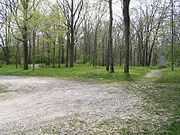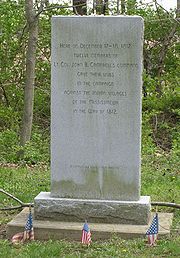
Battle of the Mississinewa
Encyclopedia
The Battle of the Mississinewa, also known as Mississineway, was an expedition ordered by William Henry Harrison
against Miami
Indian villages in response to the attacks on Fort Wayne
and Fort Harrison in the Indiana Territory
. The battle is significant as the first American victory in the War of 1812
. The site is near the city of Marion, Indiana
.
Today, the location is the site of Mississinewa 1812, the largest War of 1812 reenactment in the United States
, which is held every October. The annual festival draws thousands of visitors from all over the world. In 2004, a large memorial was unveiled and is currently on display near the Mississinewa River
in downtown Marion.

 After receiving permission from Secretary of War William Eustis
After receiving permission from Secretary of War William Eustis
, Harrison ordered Lieutenant Colonel John B. Campbell
to lead an expedition into Indiana. Campbell's objective was to destroy the Miami villages along the Mississinewa River
. If possible, he was to avoid harm to Miami chiefs Pacanne
, Jean Baptiste Richardville, White Loon, or Lenape
Chief Silver Heel. Campbell's force of 600 mounted troops departed from Fort Greenville on December 14 and traveled 80 miles (130 km) and reached Silver Heel's village on December 17 and took 42 Lenape prisoners.
The mounted force then moved down the Mississinewa River, attacking at least two Miami villages. The Indians were taken by surprise and had not evacuated. A large number of Miami were killed, and 76 were taken prisoner, including 34 women and children. Later that day, having accomplished his objective, Campbell considered returning to Fort Greenville on account of severe frostbite
among his troops.
The next morning, December 18, as Campbell returned to Silver Heel's village, a sizeable Native American force counterattacked. The American Indians were outnumbered, but fought fiercely to rescue the captured villagers being held by Campbell. A joint cavalry charge led by Captains Trotter and Johnston finally broke the attack.
The American loss was 8 killed and 48 wounded (of whom 4 later died). Campbell claimed that 8 Indians were killed on December 17 and that at least 30 were killed on December 18. 8 warriors and thirty-four women and children were captured.
One of the captured villagers told Campbell that Tecumseh
was nearby and was coming with hundreds of men, so Campbell began the return march to Fort Greenville, taking with him the 42 prisoners. It was a costly victory. During the return trek, the American force was plagued greatly by frostbite, and by the time they reached Fort Greenville on December 28, some 300 of Campbell's troops were suffering from frostbite and rendered unfit for duty. An entire regiment, under Colonel Simrale, was disbanded due to frostbite.
Harrison ordered another attack on the Mississinewa villages the following July. Although crops and houses were again destroyed, the Miami had evacuated and escaped further casualties.
William Henry Harrison
William Henry Harrison was the ninth President of the United States , an American military officer and politician, and the first president to die in office. He was 68 years, 23 days old when elected, the oldest president elected until Ronald Reagan in 1980, and last President to be born before the...
against Miami
Miami tribe
The Miami are a Native American nation originally found in what is now Indiana, southwest Michigan, and western Ohio. The Miami Tribe of Oklahoma is the only federally recognized tribe of Miami Indians in the United States...
Indian villages in response to the attacks on Fort Wayne
Siege of Fort Wayne
The Siege of Fort Wayne took place during the War of 1812, between United States and American Indian forces in the wake of the successful British campaigns of 1812.-Background:...
and Fort Harrison in the Indiana Territory
Indiana Territory
The Territory of Indiana was an organized incorporated territory of the United States that existed from July 4, 1800, until November 7, 1816, when the southern portion of the territory was admitted to the Union as the state of Indiana....
. The battle is significant as the first American victory in the War of 1812
War of 1812
The War of 1812 was a military conflict fought between the forces of the United States of America and those of the British Empire. The Americans declared war in 1812 for several reasons, including trade restrictions because of Britain's ongoing war with France, impressment of American merchant...
. The site is near the city of Marion, Indiana
Marion, Indiana
Marion is a city in Grant County, Indiana, United States. The population was 29,948 as of the 2010 census. The city is the county seat of Grant County...
.
Today, the location is the site of Mississinewa 1812, the largest War of 1812 reenactment in the United States
United States
The United States of America is a federal constitutional republic comprising fifty states and a federal district...
, which is held every October. The annual festival draws thousands of visitors from all over the world. In 2004, a large memorial was unveiled and is currently on display near the Mississinewa River
Mississinewa River
The Mississinewa River is a tributary of the Wabash River in eastern Indiana and a small portion of western Ohio in the United States. It is long. Via the Wabash and Ohio rivers, it is part of the Mississippi River watershed. During the War of 1812, the river was the site of the Battle of the...
in downtown Marion.
Expedition


William Eustis
William Eustis was an early American statesman.He was born in Cambridge, Massachusetts and studied at the Boston Latin School before he entered Harvard College, from which he graduated in 1772. He studied medicine under Dr. Joseph Warren and helped care for the wounded at the Battle of Bunker...
, Harrison ordered Lieutenant Colonel John B. Campbell
John B. Campbell
John B. Campbell was a soldier during the War of 1812, most famous for his expedition to destroy the Miami Indian villages along the Mississinewa River and perhaps most infamous for destroying private houses and other property along with the stocks of grain and mills, which led to a Court of...
to lead an expedition into Indiana. Campbell's objective was to destroy the Miami villages along the Mississinewa River
Mississinewa River
The Mississinewa River is a tributary of the Wabash River in eastern Indiana and a small portion of western Ohio in the United States. It is long. Via the Wabash and Ohio rivers, it is part of the Mississippi River watershed. During the War of 1812, the river was the site of the Battle of the...
. If possible, he was to avoid harm to Miami chiefs Pacanne
Pacanne
Pacanne was a leading Miami chief during the late 18th and early 19th centuries. Son of The Turtle , he was the brother of Tacumwah, who was the mother of Chief Jean Baptiste Richardville. Their family owned and controlled the Long Portage, an 8 mile strip of land between the Maumee and Wabash...
, Jean Baptiste Richardville, White Loon, or Lenape
Lenape
The Lenape are an Algonquian group of Native Americans of the Northeastern Woodlands. They are also called Delaware Indians. As a result of the American Revolutionary War and later Indian removals from the eastern United States, today the main groups live in Canada, where they are enrolled in the...
Chief Silver Heel. Campbell's force of 600 mounted troops departed from Fort Greenville on December 14 and traveled 80 miles (130 km) and reached Silver Heel's village on December 17 and took 42 Lenape prisoners.
The mounted force then moved down the Mississinewa River, attacking at least two Miami villages. The Indians were taken by surprise and had not evacuated. A large number of Miami were killed, and 76 were taken prisoner, including 34 women and children. Later that day, having accomplished his objective, Campbell considered returning to Fort Greenville on account of severe frostbite
Frostbite
Frostbite is the medical condition where localized damage is caused to skin and other tissues due to extreme cold. Frostbite is most likely to happen in body parts farthest from the heart and those with large exposed areas...
among his troops.
The next morning, December 18, as Campbell returned to Silver Heel's village, a sizeable Native American force counterattacked. The American Indians were outnumbered, but fought fiercely to rescue the captured villagers being held by Campbell. A joint cavalry charge led by Captains Trotter and Johnston finally broke the attack.
The American loss was 8 killed and 48 wounded (of whom 4 later died). Campbell claimed that 8 Indians were killed on December 17 and that at least 30 were killed on December 18. 8 warriors and thirty-four women and children were captured.
One of the captured villagers told Campbell that Tecumseh
Tecumseh
Tecumseh was a Native American leader of the Shawnee and a large tribal confederacy which opposed the United States during Tecumseh's War and the War of 1812...
was nearby and was coming with hundreds of men, so Campbell began the return march to Fort Greenville, taking with him the 42 prisoners. It was a costly victory. During the return trek, the American force was plagued greatly by frostbite, and by the time they reached Fort Greenville on December 28, some 300 of Campbell's troops were suffering from frostbite and rendered unfit for duty. An entire regiment, under Colonel Simrale, was disbanded due to frostbite.
Aftermath
The Indian force was only concerned with protecting their lives and winter food supplies. In order to ensure this, they needed to stop Cambell's expedition and force it to return to its base, which they did. Harrison claimed the expedition as a victory because of the prisoners that were taken, and he contemplated sending another expedition down the Mississinewa despite the fact that over half his cavalry was incapacitated either from battle wounds or frostbite. Harrison received approval and appointed Campbell a full Colonel in the Regular Army.Harrison ordered another attack on the Mississinewa villages the following July. Although crops and houses were again destroyed, the Miami had evacuated and escaped further casualties.

